| |
 |
| |
JFW-JC
has newly installed a “Supporting-Industry Corner” for enhancing
the promoting power to realize a comprehensive textile exhibition.
It has opened an independent corner in the promotion zone for executing
the index function in the supporting-industry field mainly in apparel
accessories.
18 companies have participated in the corner: IKENAKA CO.,LTD. ICHIKAWA CO.,LTD.
EIWA CO.,LTD. S PLANNING CO.,LTD. OCHIAI LACE CO.,LTD. KYOWA LACE CO., LTD. KOBAYASHI
WOVEN LABELS CO.,LTD. SUMMIT LACE, Sankei Co.,Ltd. SUN FASTENING SYSTEMS CO.,LTD.
SHIMA SEIKI MFG.,LTD. TAKASHIMA SHOJI CO.,LTD. TOKYO SANKI CO.,LTD., TORIM LACE,
NAKAMURA SHOJI CO.,LTD., BRONEW NAKASIN CO.,LTD. HORIGUCHI CO.,LTD. and YKK FASTENNING
PRODUCTS SALES INC.
SHIMA SEIKI MFG is exhibiting product samples made by “WHOLEGARMENT.” The non-seamed
knitwear made by “WHOLEGARMENT” is not only seam-less, but also features lots
of merits, such as easy to move, clear silhouette, and no waster of yarn to save
resources. The booth of SHIMA SEIKI MFG includes, aside from the “WHOLEGARMENT,”
an ink-jet printer of the flat system, and a 3-D apparel design work station
having a screen for monitoring production.
A lining dyeing factory of Sankei Co., Ltd. located in Sakai-shi, Fukui Pref.
and its subsidiary Fukusen Co., Ltd. gained the authentication of Oeco-Tex Standard
100 in March 2008. This is one of the topics at its booth. KYOWA LACE CO., LTD.
is attracting a wide audience by its exhibition of narrow-width lace, and the
new proposal of “Accessory Lace.” As usable as accessory, applications of lace
are expected to be expanded widely.
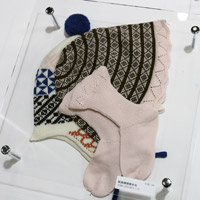 |
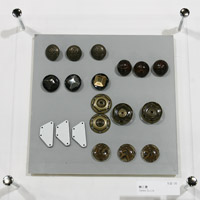 |
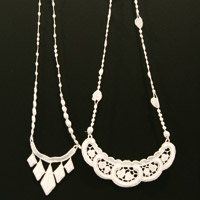 |
| SHIMA SEIKI MFG., LTD |
Sankei Co., Ltd. |
KYOWA LACE CO., LTD. |
|
| |
 |
| |
 |
| |
The portion of both sides of fabrics reinforced for weaving denim
by high-speed machines--that’s the denim’s selvage.
Denim’s selvage is cut off and discarded after being woven into fabrics. In Japan,
denim’s selvage is discarded at about 200,000 meters a day, or 72 million meters
a year, about two rounds of the earth.
Denim’s Selvage Project was realized by a meeting of KAIHARA CORPORATION, a denim
maker, with GALAXY CLUB, a creator group in the fashion industry. “Mottainai!”
cried a member of GALAXY CLUB. At JFW-JC, the denim's selvage is used in a big
objet d'art on display, and for products such as hats and bags.
According to Kazuhiko Tabata in charge of art direction:
“We held the first project exhibit at Shibuya Le Deco in July 2007. This is the
second show of the project. We intended the first show to publicize that the
denim has its selvage. This second time, we want to express the quality of denim’s
selvage. We tried every attempt to utilize the space effectively.
“The theme of this show is RE-BIRTH. The huge objet d'art sitting in the center
of the booth is a creation of dress designer Sachiko Murata. Various decorative
objects surrounding it are pieces of jewelry designer Yuko Ito.
“The denim’s selvage destined to be discarded is set at the side corner. It is
re-born into pieces of art gradually toward the center. I hope many people may
be interested in the possibility of denim’s selvage ignored and discarded so
far.”
|
| |
 |
| |
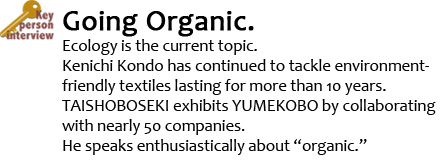 |
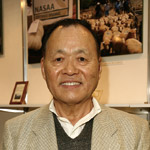 |
| Kenichi Kondo, Director and Sales Manager
of TAISHOBO INDLISTRTES., LTD |
|
Q: Every year, in every
show, many companies participated in YUMEKOBO, a booth of TAISHOBOSEKI.
The booth is very active and vivid. What’s the reason?
A: TAISHOBOSEKI is a spinning firm, and not making finished products.
To help understanding of “organic” by many people, we open Yumekobo
to display products made from organic materials made of our company.
The exhibition includes products from various manufacturers of textiles,
apparel, knit, towel, lace, dyeing, bedding, sewing and many others.
Including product cooperating companies, this is a collaboration
of nearly 50 companies.
Q: What was the motivation
of TAISHOBOSEKI to start handling organic cotton?
A: As you know, TAISHOBOUSEKI is a group company of KURABO, and many
of the jobs were handed down from Kurabo. To get out of this situation,
we started a new business campaigning environmental protection in
1995. From my-own experience, we can import cotton from 86 countries
around the world, and animal fiber from 45 countries. On the same
occasion, we started the business of “special single cotton” or non-blended
cotton for the first time in the industry.
Q: You have early faced
the environmental problem, and now the concern about ecology is mounting.
Recently, organic cotton is attracting wide attention.
A: Yet, the organic cotton is only less than 1% of total cotton production.
The production is increasing recently. Places of origin are mainly
Turkey, India, and the U.S. Africa is increasing production lately.
Q: Is there any reason?
A: The fact is organic cotton may be an economical support for developing
nations. We prepare soil recognized to be suited to organic cultivation,
and we plant organic sugar cane. After cropping, pancake (cow dung)
and earthworms turns the soil alkaline. Then organic cotton is cultivated,
and it sells about 1.5 to 2 times higher than the ordinary cotton.
It's a good business. Moreover since agricultural chemicals are not
used, the cost is saved. Organic cotton is healthy for the consumers,
and profitable for farmers. It brings about merits on both sides.
Q: But once the ecology becomes
a boom, is it destined to perish?
A: Possibly. Organic material is to be authorized by the international
certifying organization under IFORM (International Federation of
Organic Agriculture Movements). What is more important for us is
the traceability of the organic material. From the production stage
to the distribution stage, all related enterprises must be qualified
and approved lawfully. Otherwise the originality of the organic cotton
will be lost. It is very important to establish the traceability
from materials to yarns, weaving, dyeing, finished products, and
transportation.
|
| |
 |
| |
 |
| |

“ECO DOREAM” has been started by TORAY aiming at an environment-oriented
company, which is developing and proposing various products. “ECODEAR”
is a vegetable-derived product made from corn and sugar cane. “RECYCLONE”
is a recycled material. “FITTI” is a raw material combined with vegetable
derivatives. TORAY exhibits achievements of four textile departments.
Recycling of nylon 6 is a hot topic in cooperation with Patagonia.Inc.
Saving of energy, saving of refuse, saving of CO2, these activities
are realized by the comprehensive man-made fiber producer of today.
Ecology activities are becoming wider and deeper. |
| |

Wool is a traditional and natural material friendly to the environment,
and one step is moved ahead in consideration of the environment.
For example, without using chlorine, it is attempted to dye by plasma
processing. Without removing wool scale, more natural sense is left
over. “Cool Twist” is made by blending wool with fibers containing
ceramics, and by special twisting process. “Cool Through” is 100%
wool containing English wool, enhanced in air-permeability by controlling
the twisting, weaving and density. “Triangle Project” by TEIJIN,
NISSINBO, and THE JAPAN WOOL TEXILE is a collaboration of chemical
recycled fibers and wool. The wool is friendly and gentle to people
and the earth. |
| |
 |
| |

Although the majority is produced overseas, materials and spinning
conform to planning of the company. Main products are cellulosic
fiber fabrics for cut-and-sewn knitwear, and specialties are composites
of silk mixed with “Tencel”. The feature is the high-gauge jersey
having a clear finished surface. The present proposal is “Micro-Moderm”
of cellulosic/silk blend using 50s yarn. Having an abundant stock
of materials, the company is ready for producing to satisfying the
needs for quick service or small lots. |
| |

A wool fabric maker in the Bishu district, MUSHIBUN KEORI specializes
in wool fabrics, but also collaborates with producers in Hokuriku
and Hamamatsu, presenting composite-fiber products. Original products
are made by mixing 100% wool yarn for weft and filament yarn for
warp. Its main application is women’s wear such as suits, setups
and blouses. Applicable to many items except for coats. |
| |

TOA demonstrates finished products made by its bonding technology
highly evaluated among apparel makers. A sticker carving an illustration
in a leather material by laser processing is adhered to a T-shirt.
A difficult-to-say processing technology is shown in products. The
adhesive to be adhered to the T-shirt is used in bonding, and it
is washable. The group enterprises are building up a comprehensive
system from design planning to production, sales and distribution.
To meet demands for small lot production, requests of samples for
one garment are accepted. |
| |

KAIKOSHA is a specialized manufacturer of commercial flags. Using
an ink-jet printer, it prints patterns on polyester fabrics by sublimation
transfer. Recently, the company has been receiving inquiries from
apparel makers, and is starting business in the interior and bedding
fields, aside from the apparel industry. Since printing plates are
not used, the color image has cost merits, and application to QR
is excellent. The ink-jet printer is large in size, and it is applicable
to the maximum print width of 2.50 meters. The order entry lot starts
from 1 meter, and is applicable to a huge lot of 4,000 meters. Printing
materials are any polyester fabrics, whether stretch type or coarse
texture, or tough canvass type. |
| |
 |
| |
 |
| |
Tomoko Yamaguchi, a famous actress in Japan, visited TAISHOBOUSEKI’S
YUMEKOBO on April 22, before the opening day of JFW-JC. She is searching
the depth of handcrafts of Japan, and an adviser to YAMA WARAU, an
apparel brand. At the YUMEKOBO she highly evaluated the high quality
of collaboration of environment-friendly merchandise development
and creative craftsmanship of Japan. She also visited the same booth
last year.
This year, before leaving Japan for an overseas location trip, she came before
the opening day. She walked around all corners of YUMEKOBO, spending more than
an hour, while listening to the lectures of Kenichi Kondo, Director of TAISHOBOUSEKI
about bengara dyeing, stocking knitting machine, hand weaving demonstrations,
Yoshino kudzu vine root towels, soft woven 100% “Supima” cotton towels, and others.
Finally, she picked up a 4-meter-width organic cotton fabric full of cherry blossoms
on the entire surface, and made an autograph together with comments, “Thank you
for beautify nature of Japan.” Please look at her autograph when you visit the
booth.
|
| |
 |
| |
 |
| |
Fresh Hot Pizzas at the Show!
Have you noticed a delivery car carrying Cacciatura pizzas from the Italian
restaurant in Ebisu? Two varieties of pizzas, margarita and marinara, other
pastas, saltimbocca or Italian-style sandwich of freshly baked pizza dough
with toppings, and other menus are cooked at the site. The atmosphere is
filled with Italian flavor. The same taste as your eat at the restaurant.
Promotion zone district B. Try a bit if you are a little bit hungry. You
can also find a box of Mister Donuts near business zone D area.
|
|
